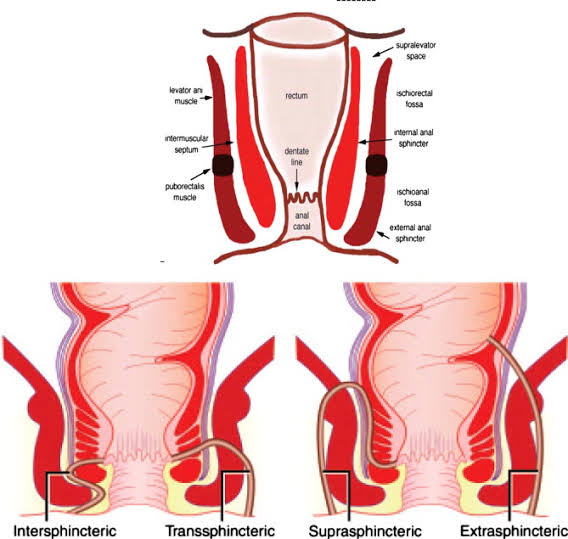Anal Fistula
Types of Fistula in Ano
Anal Fistulas are of five kinds as follows:
• Inter-sphincteric fistula – It is the outcome of a perianal abscess. In this, fistula tract forms within the internal sphincter and the intersphincteric space, and then ends at the perineum.
•Trans-sphincteric fistula – This type of fistula develops behind the anus or in between the internal and external sphincter muscles. • Supra-sphincteric fistula – They develop beside the internal and external sphincter tissues. Then they stretch up and meet the puborectalis muscle and open an inch or more away from the anus.
Fistula Symptoms
- Skin maceration
- Blood, Pus, sticky discharge or faecal discharge through the anus or fistula boils on & off.
- The sensation of anal itching and throbbing pain
- Pain throughout the anal area
- Inflammation nearby the anus
- Skin irritations and skin becomes red near anal opening.
- Elevated body temperature
- Constipation
- Some patients have pain in lumbar region on and off The signs mentioned above are beneficial to diagnose the condition of anal fistula.
Fistula Causes
- Constant long time sitting and abscess formation
- Long driving, dry eating, less water intake
- If a person is experiencing irritable bowel syndrome (IBS) which affects the digestive system and result in pain, diarrhoea, and constipation
- Diverticulitis and Crohn’s disease concerns the growth of small sacks that attaches to the large intestine
- Damage to a rectal portion
- Hidradenitis suppurativa affects the sweat glands and results in multiple conditions and recover from scarring.

Fistula Treatments
This is the most popular and convenient treatment for Fistula. In this fistula tract is partially removed and partially ksharsutra has been ligated. Every week this ksharsutra has been changed till complete cutting of the tract. It does not damage the sphincter muscle and maintains continence.
IFTAK is an advanced piles treatment that uses a non-surgical, non-invasive technique to heal and regenerate damaged tissue. The treatment is performed by expert doctors who specialize in piles treatment, using a state-of-the-art device to deliver a precise amount of energy to the affected area. This energy stimulates the body’s natural healing process, leading to the regeneration of healthy tissue and reducing the size of the piles.
LIFT, which stands for Ligation of the Intersphincteric Fistula Tract, is a minimally invasive procedure that is used to treat anal fistulas. During the procedure, a surgeon will create a small incision in the skin near the affected area. They will then use a small, curved instrument to identify the tract that connects the fistula to the anal canal. Once the tract is located, it is then ligated or tied off to allow it to heal.
New advance laser treatment is used for fistula treatment. Laser beam passed through tract and tract is burnt. The therapy is the safe, efficient, less invasive and sphincter-saving system. The procedure requires approx. 15 to 30 minutes.
It is a combination of traditional and modern techniques. We use different ayurvedic herbs to prepare medicated Seton (a thread or string). Tagging this Seton to drain the fistula. We keep Seton inside for some days. The pus and infected tissue can flow down through the Seton. Then we change this herbal thread every week. Every week this setone cut and heal the tract slowly. It does not damage the sphincter muscle.
A fistulotomy is an outpatient operational method used to treat anal fistula. The procedure requires a few minutes or an hour. In this, the doctor makes an incision in the body to open the irregular connection between the two openings.

